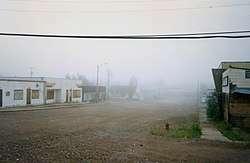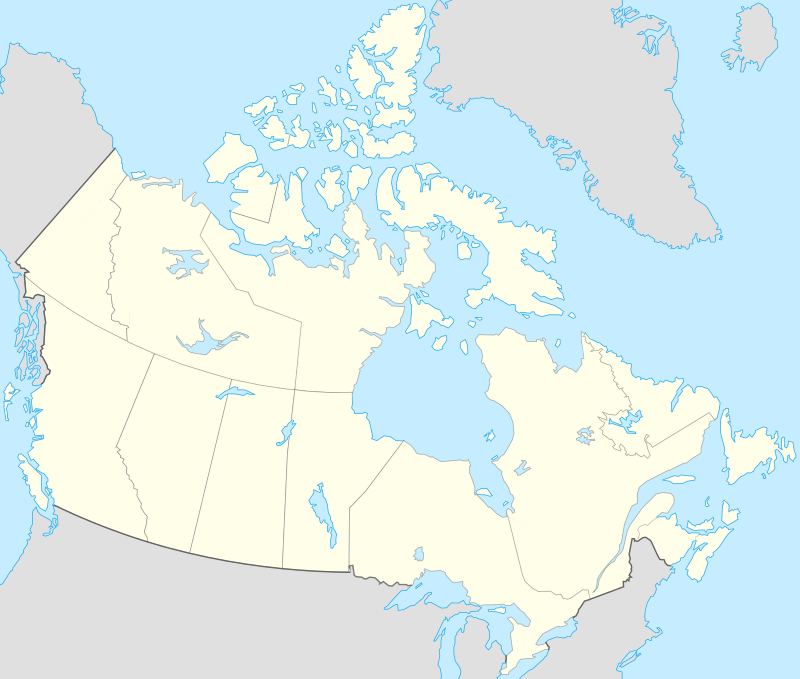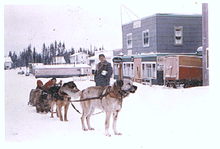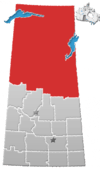Uranium City
Uranium City is a northern settlement in Saskatchewan, Canada. Located on the northern shores of Lake Athabasca near the border of the Northwest Territories, it is 230 m (750 ft) above sea level. The settlement is 760 km (470 mi) northwest of Prince Albert, 760 km (470 mi) northeast of Edmonton and 48 km (30 mi) south of the Northwest Territories-Saskatchewan boundary. For census purposes, it is located within the province's Division No. 18 territory.
Uranium City | |
|---|---|
Northern settlement[1] | |
 Main Street on a foggy day | |
 Uranium City  Uranium City | |
| Coordinates: 59°33′57″N 108°36′52″W | |
| Country | Canada |
| Province | Saskatchewan |
| Census division | Division No. 18 |
| Post office founded | N/A |
| Incorporated (village) | N/A |
| Incorporated (town) | N/A |
| Government | |
| • mayor | Jason Kraus |
| Area | |
| • Total | 6.25 km2 (2.41 sq mi) |
| Population (2016)[2] | |
| • Total | 73 |
| • Density | 4.58/km2 (11.9/sq mi) |
| Time zone | UTC−06:00 (CST) |
| Forward sortation area | S0J |
| Area code(s) | 306 |
| NTS Map | 074N10 |
| GNBC Code | HAISA |
History
In 1949, athabascaite was discovered by S. Kaiman while he was researching radioactive materials around Lake Athabasca near Uranium City.
In 1952, the provincial government decided to establish a community to service the mines in the Beaverlodge uranium area developed by Eldorado Mining and Refining, a federal crown corporation. In 1954, the local newspaper, The Uranium Times, noted that 52 mines were operating and 12 open-pit mines were next to Beaverlodge Lake.[3] Initially, most of the residences in Uranium City were simply tents.
Some of the mines operating in the area included the Gunnar Mine, the Lorado Mine, and the Fay-Ace-Verna Mine in Eldorado, Saskatchewan.
Two options were considered for communities in the region: small communities near the mine site or larger more centralized communities with adequate services. Not wanting to replicate some of the problems associated with small mining towns at the time in Northern Ontario, the government pushed for the second option and modelled Uranium City after the community of Arvida, Quebec. [4]
The population of Uranium City started to grow significantly only once Eldorado Resources made a deliberate initiative in 1960 to see staff housed in Uranium City instead of the Eldorado campsite.[4]
Uranium City was a thriving community until 1982, with its population approaching the 5,000 threshold required to achieve city status in the province. The closure of the mines on 30 June 1982 led to economic collapse, with most residents of the community leaving. It was later designated as a northern settlement with about 300 people remaining. The local hospital closed in the spring of 2003. The current population is 73,[2] including a number of Métis and First Nations people.[5]
Transportation
The community has a certified airport, Uranium City Airport, that features a treated gravel runway of 3,935 ft (1,199 m) operated by the Saskatchewan Ministry of Highways and Infrastructure. The airport is one of the few employers left in the community. West Wind Aviation previously served Uranium City with flights to Prince Albert and Saskatoon three times a week. Norcanair served the community with scheduled flights until it ceased operations in 2005.[6] Transwest Air also provided a route with Saskatoon and Regina until that company cancelled its service in November 2008.[7][8] It now serves Uranium City with a flight from Saskatoon that stops in Prince Albert, Points North and Stony Rapids.[9] There is also a small water aerodrome located next to Uranium City.
There is no normal road access connecting Uranium City with the rest of Canada. There is provision for a winter road which connects with Fond-du-Lac.[10] Saskatchewan Highway 962 provides travel for a short distance within the local area. A significant bridge replacement project on Highway 962 was conducted in 2001 at the Fredette River.[11]
Communications

Local telephone service is provided by SaskTel and was first available in Uranium City on November 30, 1955.[12] Current telephone numbers for international calling are of the form +1 306 498 xxxx (NPA-NXX: 306–498, CLLI: URCYSK05DS0).[13]
Canada Post continues to deliver mail to the community. The post office is located at the municipal office (Postal Code: S0J 2W0).[14]
Radio broadcasting in the community is provided by:
- 97.9 FM – VF2142 – rebroadcasts CKRW-FM[15]
- 99.9 or 101.1 FM – Missinipi Broadcasting Corporation[16]
- 103.1 FM – VF2240 – rebroadcasts CFMI-FM[15]
- 105.1 FM – CBDH-FM, CBC Radio One, rebroadcasting CBKA-FM La Ronge.[17]
Until 2012, television service was provided by CBKAT operating on channel 8 at a power of 15 watts. This was a rebroadcaster of CBC Television service from CBKST Saskatoon. Until 2003, the local transmitter's television programming originated from CBC North.[18] This repeater was one of 620 analog television signals nationwide shut down by the CBC on July 31, 2012 due to budget cuts.
Climate
Uranium City is part of the Taiga Shield Ecozone and experiences a subarctic climate (Köppen Dfc) with long, cold, snowy winters, brief transitional periods, and short, cool, and humid summers. The temperature range is typically large due to frigidly cold winter temperatures that often plunge below −30 °C (−22 °F). The highest temperature ever recorded in the settlement was 34.7 °C (94.5 °F) on 27 July 1984.[19] Wind chill factors are prominent as well in the winter months, making the cold temperatures seem to be much colder than they actually are. Uranium City has recorded one of the coldest wind chill factors of any Canadian location, with −74 wind chill reading being recorded on 28 January 2002. Additionally, an average of 34 days a year record wind chill readings below −40.[20] The lowest temperature ever recorded in the settlement was −48.9 °C (−56.0 °F) on 15 January 1974.[19]
| Climate data for Uranium City Airport | |||||||||||||
|---|---|---|---|---|---|---|---|---|---|---|---|---|---|
| Month | Jan | Feb | Mar | Apr | May | Jun | Jul | Aug | Sep | Oct | Nov | Dec | Year |
| Record high °C (°F) | 3.3 (37.9) |
5.9 (42.6) |
11.6 (52.9) |
28.9 (84.0) |
31.6 (88.9) |
34.4 (93.9) |
34.7 (94.5) |
32.8 (91.0) |
29.4 (84.9) |
20.0 (68.0) |
10.5 (50.9) |
5.9 (42.6) |
34.7 (94.5) |
| Average high °C (°F) | −21.8 (−7.2) |
−16.2 (2.8) |
−8.1 (17.4) |
3.7 (38.7) |
12.8 (55.0) |
18.8 (65.8) |
21.3 (70.3) |
19.3 (66.7) |
11.3 (52.3) |
3.8 (38.8) |
−8.1 (17.4) |
−17.7 (0.1) |
1.6 (34.9) |
| Daily mean °C (°F) | −26.8 (−16.2) |
−22 (−8) |
−15 (5) |
−2.4 (27.7) |
6.9 (44.4) |
13.3 (55.9) |
16.2 (61.2) |
14.5 (58.1) |
7.3 (45.1) |
0.5 (32.9) |
−11.8 (10.8) |
−22.1 (−7.8) |
−3.5 (25.7) |
| Average low °C (°F) | −31.9 (−25.4) |
−28.0 (−18.4) |
−22.0 (−7.6) |
−8.6 (16.5) |
1.0 (33.8) |
7.7 (45.9) |
11.0 (51.8) |
9.6 (49.3) |
3.3 (37.9) |
−2.8 (27.0) |
−15.7 (3.7) |
−26.7 (−16.1) |
−8.6 (16.5) |
| Record low °C (°F) | −48.9 (−56.0) |
−48.3 (−54.9) |
−42.8 (−45.0) |
−37.8 (−36.0) |
−16.7 (1.9) |
−5.0 (23.0) |
3.2 (37.8) |
−1.4 (29.5) |
−9.4 (15.1) |
−25.9 (−14.6) |
−41.7 (−43.1) |
−45.6 (−50.1) |
−48.9 (−56.0) |
| Average precipitation mm (inches) | 20.7 (0.81) |
14.8 (0.58) |
18.6 (0.73) |
19.2 (0.76) |
21.4 (0.84) |
37.8 (1.49) |
53.0 (2.09) |
53.5 (2.11) |
37.3 (1.47) |
35.9 (1.41) |
29.2 (1.15) |
20.6 (0.81) |
361.8 (14.24) |
| Average rainfall mm (inches) | 0.0 (0.0) |
0.0 (0.0) |
0.2 (0.01) |
4.6 (0.18) |
17.6 (0.69) |
37.7 (1.48) |
53.0 (2.09) |
53.3 (2.10) |
35.7 (1.41) |
21.1 (0.83) |
0.3 (0.01) |
0.2 (0.01) |
223.7 (8.81) |
| Average snowfall cm (inches) | 32.9 (13.0) |
24.8 (9.8) |
27.7 (10.9) |
18.9 (7.4) |
4.4 (1.7) |
0.0 (0.0) |
0.0 (0.0) |
0.2 (0.1) |
2.0 (0.8) |
19.2 (7.6) |
48.3 (19.0) |
36.7 (14.4) |
215.1 (84.7) |
| Average precipitation days | 12 | 10 | 9 | 7 | 8 | 10 | 11 | 12 | 12 | 12 | 15 | 13 | 130 |
| Average rainy days (≥ 0.2 mm) | 0 | trace | trace | 2 | 7 | 10 | 11 | 12 | 11 | 7 | trace | trace | 60 |
| Average snowy days (≥ 0.2 cm) | 14 | 11 | 10 | 6 | 2 | trace | 0 | trace | 2 | 8 | 16 | 16 | 84 |
| Source: [19] | |||||||||||||
Education
Education in Uranium City is under the authority of the Northern Lights School Division #113, a school district that covers most of northern Saskatchewan. The only remaining school in Uranium City is Ben McIntyre School, serving classes from kindergarten to Grade 9. The school opened in 1977 and is named after the first teacher in Uranium City who established the first school in the community in 1952 with 40 students in ten grades. As of September 2005, 10 students were enrolled.[21]
Secondary education was provided by CANDU High School, named after a nuclear reactor. According to travelers Vincent Chan and Tricia Holopina who visited the city in 2002, locals state that the school was opened in 1980 and closed in 1983 after only three years of service, with the building since sustaining extensive vandalism.[22][23]
Notable people
The following people are associated with Uranium City by birth, residence or career:
- Bert Burry, pilot and ice hockey player
- Gina Kingsbury, member of gold medal winning Canadian women's ice hockey team at the 2006 Winter Olympics
- Gilbert LaBine, a founder of the Gunnar Mine
See also
- List of communities in Northern Saskatchewan
- List of communities in Saskatchewan
- List of uranium projects
- Athabasca System Hydroelectric Stations
- Jeffrey City, Wyoming
References
- "Search for Municipal Information". Government of Saskatchewan. Archived from the original on 10 March 2014. Retrieved 7 April 2014.
- "Census Profile, 2016 Census". Statistics Canada. 14 April 2017. Retrieved 16 May 2017.
- Fission Avenue: Uranium City "Beaverlodge"
- "Chapter 7. Uranium Mining in Northern Saskatchewan: A Public-Private Transition (Part 2)". International Development Research Centre. Archived from the original on 9 June 2011. Retrieved 22 February 2011.
- Fission Avenue: Uranium City Pg2
- "Soaring insurance grounds airline". CBC Saskatchewan. Archived from the original on 1 April 2007. Retrieved 2 September 2006.
- "Transwest cuts flights to Regina and Uranium City". Leader-Post. Regina. 27 October 2008. Archived from the original on 3 December 2012.CS1 maint: BOT: original-url status unknown (link)
- "Uranium City Schedule". Transwest Air. Archived from the original on 18 June 2006. Retrieved 2 September 2006.
- Maclean's, "An epic quest to find the soul of a country", by Allen Abel
- "Winter Highway Conditions". Saskatchewan Highways and Transportation. Retrieved 1 September 2006.
- Jim McGeary, Doug Lowry (March 2003). "Culvert headwall system conquers site constraints at Uranium City". Environmental Science and Engineering Magazine. Retrieved 19 November 2018.
- "SaskTel history (1950s)". Archived from the original on 25 March 2006. Retrieved 2 September 2006.
- "Local Calling Guide". Retrieved 2 September 2006.
- Canada Post Archived 21 April 2009 at the Wayback Machine listings as of 2 September 2006.
- CRTC (11 August 1994). "Broadcasting Decision CRTC 94-578". Retrieved 11 November 2009.
- "Communities List". Missinipi Broadcasting Corporation. Archived from the original on 27 May 2006. Retrieved 4 September 2006. Frequency information is inconsistent – this source indicates frequency is 101.1 FM but other sources claim 99.9 FM.
- CRTC (24 August 2006). "Broadcasting Decision CRTC 2006-409". Archived from the original on 27 March 2007. Retrieved 2 September 2006.
- CRTC (16 June 2003). "Broadcasting Decision CRTC 2003-186". Archived from the original on 21 April 2005. Retrieved 2 September 2006.
- "Canadian Climate Normals 1961–1990". Environment Canada. Retrieved 12 January 2012.
- The Weather Network
- "2005–2006 Active List of Saskatchewan Schools" (PDF). 5 January 2006. Archived from the original (PDF) on 22 September 2006. Retrieved 2 September 2006.
- "Tricia and Vince's Saskatchewan Trip 2002". Archived from the original on 19 February 2006. Retrieved 2 September 2006.
- Fission Avenue: Uranium City "Candu High"
